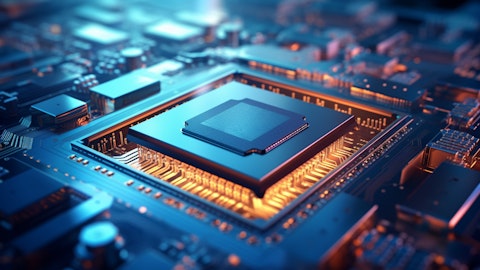Jeff Su: Okay. Thank you, Brett. So Brett’s first question is looking at the AI-related demand. He notes that AI customers are earning very good returns, HBM and other components as well. So his question is that whether TSMC, do we feel we are earning or capturing our fair value or right value of the returns? And I think on pricing, how would we price for AI basically, I think. Brett, sorry, that’s your question, right?
Brett Simpson: That’s it.
C. C. Wei: Well, let me answer the questions. We always say that we want to sell our value, but it is a continuous process for TSMC. And let me tell you that we are working on it. We are happy that our customers are doing well. And if customers do well, TSMC does well. So let me summarize it. We are working on it, and we hopefully that we can sell our value.
Brett Simpson: Right. For my follow-up question, I wanted — yes, that’s great, Jeff. And my follow-up question was on the lighting edge nodes at TSMC. And looking at Q1 sales for 12-nanometer and above, your overall revenues for these nodes collectively was off 20% year-on-year, and it’s only 35% of your overall sales. Can you maybe share with us whether you see a recovery at all this year at these nodes? And we’re seeing a lot of government support in building out new fabs in the U.S. and China around lighting edge nodes. So are you concerned at all about structural overcapacity for the older nodes to the cycle?
Jeff Su: Okay. Thank you, Brett. So Brett’s second question is more on the mature nodes. He notes that the demand for our mature nodes, 12-nanometer and older, are down year-over-year. So he wonders sort of what is the outlook for the recovery of mature nodes in the second half of the year. I think that’s the first part of his question.
C. C. Wei: Okay. Brett, let me answer this question. First, the mature node demand remains sluggish because of a site. As we just announced it, the whole semiconductor industry is gradually recovering, but not fast enough. So we expect to gradually improve in the second half of 2024. As you mentioned that you — do we have a concern on the overcapacity because of some of the companies, they continue to build a lot of mature node capacity. For us, actually, our strategy at a mature node is work closely with our strategic customers to develop specialty technology solution to meet their requirement. And we create and long-lasting value to customers. So we have less exposed to this possible overcapacity environment. And we believe that our utilization and profitability on mature node can be well protected.
Jeff Su: Does that answer your second question, Brett?
Brett Simpson: That’s clear.
Operator: Next one, we have Randy Abrams, UBS.
Randy Abrams: I wanted to ask a question, following up on C. C.’s comment about a ramp profile similar to 3-nanometer for 2-nanometer. Could you clarify for the timing of the meaningful revenue ramp for that node? Is the expectation that would be starting early 2026 and ramping up steep through 2026? Or any potential to pull that in? And then just a second question on that is you noted that tape-outs are higher. Would there be potential with higher tape-outs in 3 and 5 for either steeper or it ramps to be larger than the prior nodes once underway or looking out a couple of years?
Jeff Su: Okay. So Randy’s first question is around 2-nanometer. So his first question is to C. C. with that we said that the N2 ramp profile will be similar to N3. We also said, of course, the production begins in 2025. So his question partly is, when do we expect to see the revenue contribution, meaningful revenue contribution from N2? And then also that with N2, the tape-outs being higher, what is the multiyear opportunity or contribution from N2 maybe in terms of the revenue as compared to N3 or other nodes?
C. C. Wei: Randy, the N2’s ramp profile we say is very similar to N3 because of, look at the cycle time, we start the N2 production in the second half of 2025, actually in the last quarter of 2025. And because of the cycle time and all the kind of back-end process, and so we expect the meaningful revenue will start from the end of the first quarter or beginning of the second quarter of 2026. That’s what we mean that is the profile is very similar to N3. Now your second question is there have been a lot of engagement and the tape-out will be higher, and do we see a very steep kind of a production? Well, we do expect that, but let me say again, N2 is a very complicated work or a very complex technology node. So my customer, they also take a little bit longer time to prepare for the tape-out.
So that’s why they all engage with TSMC in the early stage. And — but for their product ramp-up, they will have their own product road map and their own business consideration. However, we still say that N2 will be a very, very big node for TSMC. Randy, does that answer your question?
Randy Abrams: Okay. Great. No, that’s helpful color. Yes. Yes, it does. No, helpful color. My second question is just relating to the upward expectations you gave for the AI accelerators. Curious how that ties to how you’re looking at the CapEx, if you say that we’re entering either higher growth or investment cycle, where capital intensity could need to rise up above that mid-30s range that you set or at least in absolute dollars from the $30 billion this year, we should start growing or thinking about CapEx at least growing with revenue.
Jeff Su: Okay. So Randy’s second question is basically, I think, with such strong AI-related demand, what does this mean for our CapEx and capacity planning? And also, what does this mean for our capital intensity outlook?





